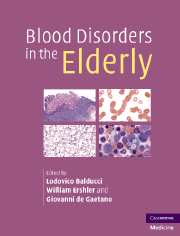Book contents
- Frontmatter
- Contents
- List of contributors
- Preface
- Part I Epidemiology
- Part II Hematopoiesis
- Part III Anemia of aging
- Part IV Hematologic malignancies and aging
- Part V Disorders of hemostasis in the elderly
- 26 Acquired hemophilia in the elderly
- 27 Blood coagulation and aging
- 28 Platelet disorders in the elderly
- 29 Gene—environment interactions and vascular risk in the elderly
- 30 Antithrombotic therapy: guidelines for the elderly
- Index
30 - Antithrombotic therapy: guidelines for the elderly
from Part V - Disorders of hemostasis in the elderly
Published online by Cambridge University Press: 21 October 2009
- Frontmatter
- Contents
- List of contributors
- Preface
- Part I Epidemiology
- Part II Hematopoiesis
- Part III Anemia of aging
- Part IV Hematologic malignancies and aging
- Part V Disorders of hemostasis in the elderly
- 26 Acquired hemophilia in the elderly
- 27 Blood coagulation and aging
- 28 Platelet disorders in the elderly
- 29 Gene—environment interactions and vascular risk in the elderly
- 30 Antithrombotic therapy: guidelines for the elderly
- Index
Summary
Introduction
The purpose of this chapter is to summarize antithrombotic therapy guidelines that specifically address the elderly. Guidelines for elderly patients differ from those for younger populations because advanced age often represents an exclusion criterion in epidemiologic and clinical studies. Guidelines that focus on the elderly are also required because of differences in baseline risks for both target outcomes that need to be prevented and adverse outcomes that develop as a consequence of an intervention. The latter point is of importance because management decisions always involve a tradeoff between benefits and downsides (harms, burden, and cost of an action).
Methods
In this chapter we focus on existing clinical practice guidelines. We searched the Seventh ACCP Conference on Antithrombotic and Thrombolytic Therapy: Evidence-based Guidelines (AT7) for guidelines related to elderly patients. AT7 is one of the leading international resources for the treatment and prevention of thromboembolic disorders, compiled by over 80 panel members who produced a series of 22 chapters published in a supplement of the journal Chest. The guidelines are based on comprehensive evaluations of the literature and include graded evidence-based recommendations that consider the quality of evidence and the strength of a recommendation. Grade 1 recommendations are strong, and indicate that the benefits do, or, for recommendations to not take an action, do not, outweigh the harms, burdens, and costs.
- Type
- Chapter
- Information
- Blood Disorders in the Elderly , pp. 448 - 466Publisher: Cambridge University PressPrint publication year: 2007



